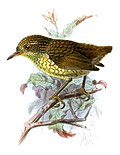| Phyllomyias | |
|---|---|
 | |
| Planalto tyrannulet (Phyllomyias fasciatus) | |
| Scientific classification | |
| Kingdom: | Animalia |
| Phylum: | Chordata |
| Class: | Aves |
| Order: | Passeriformes |
| Family: | Tyrannidae |
| Genus: | Phyllomyias Cabanis & Heine, 1860 |
| Type species | |
| Platyrhynchus brevirostris Planalto tyrannulet Spix, 1825 | |
Phyllomyias is a genus of small birds in the tyrant-flycatcher family Tyrannidae. They are found in wooded habitats of Central and South America. Some species are among the most common birds in their range, while other are rare and threatened. They have a short, stubby bill, are greenish above, yellowish or whitish below, and all except the sooty-headed tyrannulet have pale wing-bars or edging. They feed on small arthropods and fruits. Most species regularly take part in mixed species flocks.







